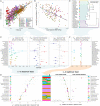Reservoir host immunology and life history shape virulence evolution in zoonotic viruses
- PMID: 37676899
- PMCID: PMC10484437
- DOI: 10.1371/journal.pbio.3002268
Reservoir host immunology and life history shape virulence evolution in zoonotic viruses
Abstract
The management of future pandemic risk requires a better understanding of the mechanisms that determine the virulence of emerging zoonotic viruses. Meta-analyses suggest that the virulence of emerging zoonoses is correlated with but not completely predictable from reservoir host phylogeny, indicating that specific characteristics of reservoir host immunology and life history may drive the evolution of viral traits responsible for cross-species virulence. In particular, bats host viruses that cause higher case fatality rates upon spillover to humans than those derived from any other mammal, a phenomenon that cannot be explained by phylogenetic distance alone. In order to disentangle the fundamental drivers of these patterns, we develop a nested modeling framework that highlights mechanisms that underpin the evolution of viral traits in reservoir hosts that cause virulence following cross-species emergence. We apply this framework to generate virulence predictions for viral zoonoses derived from diverse mammalian reservoirs, recapturing trends in virus-induced human mortality rates reported in the literature. Notably, our work offers a mechanistic hypothesis to explain the extreme virulence of bat-borne zoonoses and, more generally, demonstrates how key differences in reservoir host longevity, viral tolerance, and constitutive immunity impact the evolution of viral traits that cause virulence following spillover to humans. Our theoretical framework offers a series of testable questions and predictions designed to stimulate future work comparing cross-species virulence evolution in zoonotic viruses derived from diverse mammalian hosts.
Copyright: © 2023 Brook et al. This is an open access article distributed under the terms of the Creative Commons Attribution License, which permits unrestricted use, distribution, and reproduction in any medium, provided the original author and source are credited.
Conflict of interest statement
The authors have declared that no competing interests exist.
Figures



Comment in
-
Predicting the virulence of future emerging zoonotic viruses.PLoS Biol. 2023 Sep 8;21(9):e3002286. doi: 10.1371/journal.pbio.3002286. eCollection 2023 Sep. PLoS Biol. 2023. PMID: 37682826 Free PMC article.
Similar articles
-
Accelerated viral dynamics in bat cell lines, with implications for zoonotic emergence.Elife. 2020 Feb 3;9:e48401. doi: 10.7554/eLife.48401. Elife. 2020. PMID: 32011232 Free PMC article.
-
Host phylogenetic distance drives trends in virus virulence and transmissibility across the animal-human interface.Philos Trans R Soc Lond B Biol Sci. 2019 Sep 30;374(1782):20190296. doi: 10.1098/rstb.2019.0296. Epub 2019 Aug 12. Philos Trans R Soc Lond B Biol Sci. 2019. PMID: 31401961 Free PMC article.
-
[Bats and Viruses: complex relationships].Bull Soc Pathol Exot. 2015 Oct;108(4):272-89. doi: 10.1007/s13149-015-0448-z. Epub 2015 Sep 1. Bull Soc Pathol Exot. 2015. PMID: 26330152 Free PMC article. Review.
-
Bats host the most virulent-but not the most dangerous-zoonotic viruses.Proc Natl Acad Sci U S A. 2022 Apr 5;119(14):e2113628119. doi: 10.1073/pnas.2113628119. Epub 2022 Mar 29. Proc Natl Acad Sci U S A. 2022. PMID: 35349342 Free PMC article.
-
Immunological features of bats: resistance and tolerance to emerging viruses.Trends Immunol. 2024 Mar;45(3):198-210. doi: 10.1016/j.it.2024.01.008. Epub 2024 Mar 6. Trends Immunol. 2024. PMID: 38453576 Review.
Cited by
-
Seoul orthohantavirus evades innate immune activation by reservoir endothelial cells.PLoS Pathog. 2024 Nov 25;20(11):e1012728. doi: 10.1371/journal.ppat.1012728. eCollection 2024 Nov. PLoS Pathog. 2024. PMID: 39585900 Free PMC article.
-
Detection of Brno loanvirus (Loanvirus brunaense) in common noctule bats (Nyctalus noctula) in Southern Russia.Braz J Microbiol. 2025 Mar;56(1):675-682. doi: 10.1007/s42770-024-01587-5. Epub 2024 Dec 12. Braz J Microbiol. 2025. PMID: 39666163
-
Ebolavirus evolution and emergence are associated with land use change.Ecol Monogr. 2025 Feb;95(1):e1641. doi: 10.1002/ecm.1641. Ecol Monogr. 2025. PMID: 40546934
-
RNAVirHost: a machine learning-based method for predicting hosts of RNA viruses through viral genomes.Gigascience. 2024 Jan 2;13:giae059. doi: 10.1093/gigascience/giae059. Gigascience. 2024. PMID: 39172545 Free PMC article.
-
Predicting the virulence of future emerging zoonotic viruses.PLoS Biol. 2023 Sep 8;21(9):e3002286. doi: 10.1371/journal.pbio.3002286. eCollection 2023 Sep. PLoS Biol. 2023. PMID: 37682826 Free PMC article.
References
-
- André JB, Hochberg ME. Virulence evolution in emerging infectious diseases. Evolution. 2005;59(7):1406. - PubMed
Publication types
MeSH terms
Grants and funding
LinkOut - more resources
Full Text Sources
Medical

